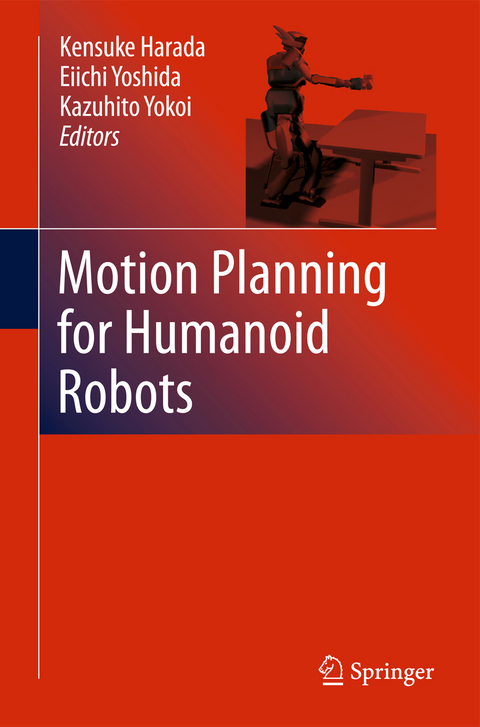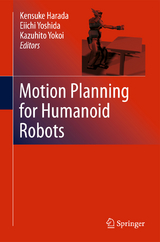Motion Planning for Humanoid Robots
Springer London Ltd (Verlag)
978-1-84996-219-3 (ISBN)
Research on humanoid robots has been mostly with the aim of developing robots that can replace humans in the performance of certain tasks. Motion planning for these robots can be quite difficult, due to their complex kinematics, dynamics and environment. It is consequently one of the key research topics in humanoid robotics research and the last few years have witnessed considerable progress in the field. Motion Planning for Humanoid Robots surveys the remarkable recent advancement in both the theoretical and the practical aspects of humanoid motion planning.
Various motion planning frameworks are presented in Motion Planning for Humanoid Robots, including one for skill coordination and learning, and one for manipulating and grasping tasks. The problem of planning sequences of contacts that support acyclic motion in a highly constrained environment is addressed and a motion planner that enables a humanoid robot to push an object to a desired location on a cluttered table is described. The main areas of interest include:
• whole body motion planning,
• task planning,
• biped gait planning, and
• sensor feedback for motion planning.
Torque-level control of multi-contact behavior, autonomous manipulation of moving obstacles, and movement control and planning architecture are also covered.
Motion Planning for Humanoid Robots will help readers to understand the current research on humanoid motion planning. It is written for industrial engineers, advanced undergraduate and postgraduate students.
Kensuke Harada received M.E. and Ph.D degrees in Mechanical Engineering from the Graduate School of Engineering, Kyoto University, in 1994 and 1997, respectively. After being employed as a research associate at Hiroshima University, he joined the National Institute of Advanced Industrial Science and Technology (AIST) in 2002. He spent a year, from November 2005 to November 2006, as a visiting scholar at Stanford University's Computer Science Department. In 2001 he was awarded the IEEE ISATP Outstanding Paper Award and in 2004 he received the IEEE ICRA Best Video Award. Eiichi Yoshida received M.E and Ph.D degrees in Precision Machinery Engineering from the Graduate School of Engineering, the University of Tokyo in 1993 and 1996, respectively. In 1996 he joined the former Mechanical Engineering Laboratory, now the National Institute of Advanced Industrial Science and Technology (AIST), Tsukuba, Japan. From 1990 to 1991, he was a visiting research associate at the Swiss Federal Institute of Technology at Lausanne (EPFL). He served as co-director of AIST/IS-CNRS/ST2I Joint French-Japanese Robotics Laboratory (JRL) at LAAS-CNRS, Toulouse, France, from 2004 to 2008. He is currently co-director of CNRS-AIST JRL (Joint Robotics Laboratory), UMI3218/CRT, AIST, Japan, since 2009. His research interests include robot task and motion planning, modular robotic systems, and humanoid robots. Kazuhito Yokoi is the leader of the Humanoid Research Group and deputy director of the Intelligent Systems Research Institute at AIST. He received his BE degree in Mechanical Engineering from the Nagoya Institute of Technology in 1984, and his ME and PhD degrees in Mechanical Engineering Science from the Tokyo Institute of Technology in 1986 and 1994, respectively. In 1986, he joined the Mechanical Engineering Laboratory, Ministry of International Trade and Industry. He is also a member of CNRS-AIST JRL, UMI3218/CRT and an adjunct professor at the Cooperative Graduate School of the University of Tsukuba. From November 1994 to October 1995, he was a visiting scholar at the Robotics Laboratory in Stanford University's Computer Science Department. His research interests include humanoids and human-centered robotics.
Navigation and Gait Planning.- Compliant Control of Whole-body Multi-contact Behaviors in Humanoid Robots.- Whole-body Motion Planning – Building Blocks for Intelligent Systems.- Planning Whole-body Humanoid Locomotion, Reaching, and Manipulation.- Efficient Motion and Grasp Planning for Humanoid Robots.- Multi-contact Acyclic Motion Planning and Experiments on HRP-2 Humanoid.- Motion Planning for a Humanoid Robot Based on a Biped Walking Pattern Generator.- Autonomous Manipulation of Movable Obstacles.- Multi-modal Motion Planning for Precision Pushing on a Humanoid Robot.- A Motion Planning Framework for Skill Coordination and Learning.
| Erscheint lt. Verlag | 18.8.2010 |
|---|---|
| Zusatzinfo | 18 Tables, black and white; XV, 306 p. |
| Verlagsort | England |
| Sprache | englisch |
| Maße | 155 x 235 mm |
| Gewicht | 712 g |
| Themenwelt | Informatik ► Theorie / Studium ► Künstliche Intelligenz / Robotik |
| Technik ► Elektrotechnik / Energietechnik | |
| ISBN-10 | 1-84996-219-7 / 1849962197 |
| ISBN-13 | 978-1-84996-219-3 / 9781849962193 |
| Zustand | Neuware |
| Haben Sie eine Frage zum Produkt? |
aus dem Bereich




